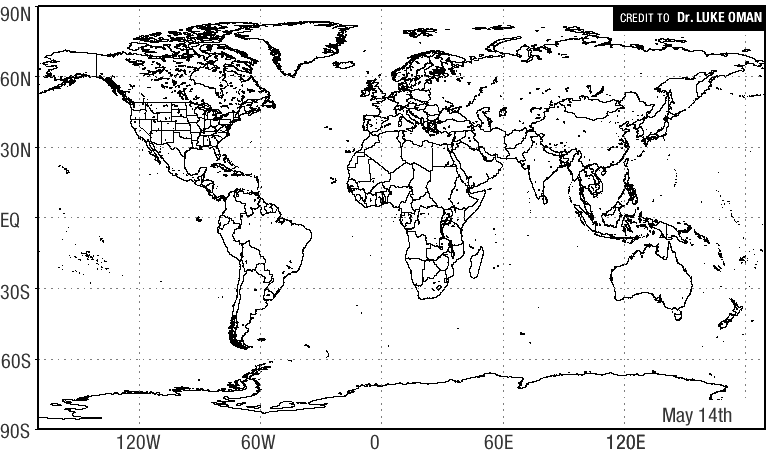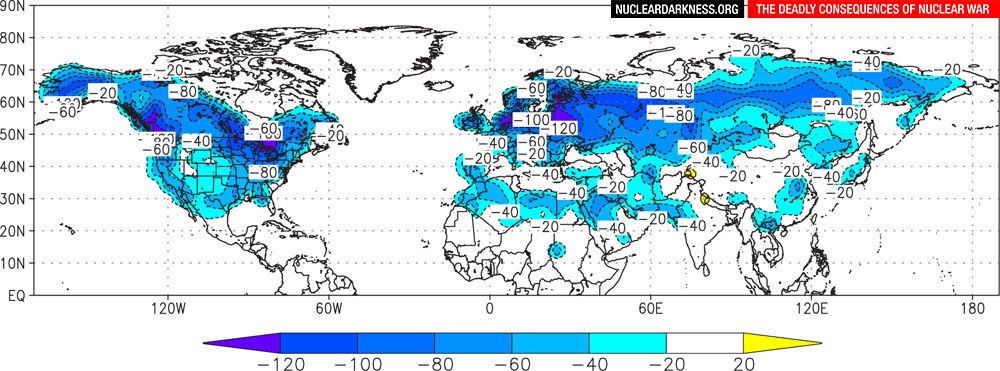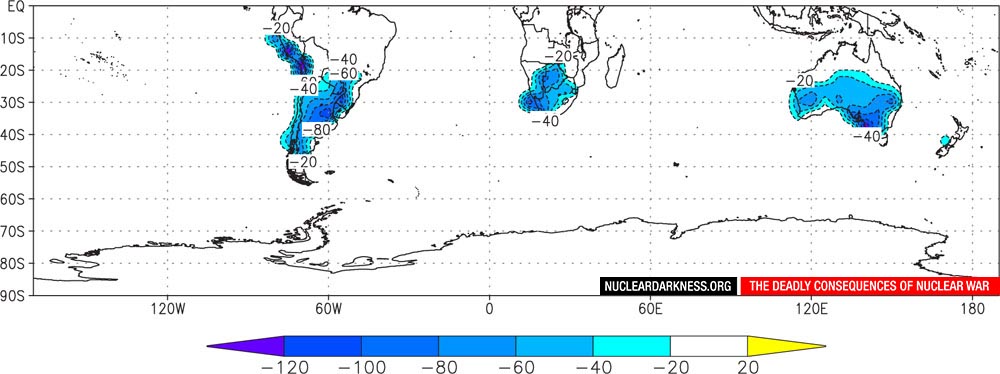

Following a large U.S.-Russian nuclear war, 50 million tons of smoke is lofted high into the stratosphere and is quickly spread around the world. A dense smoke layer quickly forms around both Hemispheres which will remain in place for many years to block sunlight from reaching the surface of the Earth. Growing seasons would be virtually eliminated in the Northern Hemisphere for many years.
War fought with High-alert and Deployed U.S.-Russian nuclear weapons, 50 million tons of smoke in stratosphere
The same sequence of events takes place as it does for the 150 million tons scenario (listed above). The only difference is that that about half as much light is blocked in this scenario, thus temperatures fall about half as much.
Unfortunately, the resulting average surface temperatures on Earth would still be as cold or colder than they were during the height of the last Ice Age, 18,000 years ago. Growing seasons would still be virtually eliminated for many years (see figure below). It would be impossible to grow food for years, and the results would be the same. Most people and many complex living things (animals high on the food chains) would starve.
The reason this 50 million tons scenario was created comes from the fact that it is impossible to predict exactly how much smoke will be created in a large nuclear war. It all depends upon how the nuclear weapons are targeted and how much smoke is produced by the fires created by their detonations.
Consider that the U.S. and Russia each have only a couple hundred cities with populations greater than 100,000 people. The odds seem good that in the event of war, many if not most of these cities will become targets for the 7,000 operational and deployed U.S.-Russian strategic weapons available for almost immediate use. And cities are where enormous amounts of flammable material are located (along with oil refineries, which are also targets).
Likewise, there are probably only a little more than one hundred cities in France and England (nuclear weapon states) with populations that contain populations of greater than a 100,000. Similar population levels exist in the NATO states that base U.S. nuclear weapons upon their soil (thus making them targets for Russian nuclear weapons). Every one of these cities will have a good chance of being targeted with one or more nuclear weapons in the event of nuclear war.
Based on the calculations done in the study “Nuclear winter revisited with a modern climate model and current nuclear arsenals”, the detonation of the U.S. and Russian nuclear forces now on high-alert, plus another 20% of their operational nuclear arsenals would cause at least 50 million tons of smoke to enter the stratosphere. It is important to understand that this is probably the minimum amount of smoke that would created by this level of conflict.
However, the scientists who have done these calculations have recently produced newer data predicting that less than half of the currently deployed U.S. and Russian nuclear weapons are capable of producing 180 million tons of smoke. The data is for 4,000 nuclear warheads, the number of warheads which is supposed to be left in 2012 at the conclusion of the current Strategic Offensive Reductions Treaty between the U.S. and the Russian Federation.
Regardless if a large nuclear war produces 50 or 150 million tons of smoke, it will surely have catastrophic results which will likely prove fatal to most people on the planet. There is no way to minimize the consequences of this scenario. Our only hope is to prevent it from occurring.


Change in growing season (the period of frost-free days) in the third year after a large U.S.-Russian nuclear war causes 50 millions tons of smoke to enter the stratosphere.